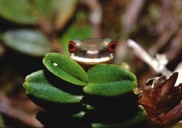|
Description
The dorsal coloration is a uniform "leaf-green," the throat and belly are
bright yellow, and the ventral side of the limbs is dull yellow
(Savage and Heyer 1968). The dorsal thigh surface appears dull yellow
or apricot colored, and there are no melanophores except under toe digits III,
IV, V. A yellow-white stripe extends from the upper lip to the groin, a
bright white stripe runs over the anus, and white stripes run over the arm, and from foot to heel. The dorsum, chin, chest and underarm are
smooth, and the belly and ventral thigh are granular. The iris is bright
red and the pupil is horizontal. The tympanum is 3/5 to 4/5 the size
of the eye. The snout is rounded in profile and truncate in dorsal outline
(Savage and Heyer 1968). Fingers are approximately one third webbed
(vestigal between fingers I and II), toes are about two thirds webbed, and
both toes and fingers bear moderate sized discs (Duellman 1970). Warts
are present along the heel stripe, often formed into a small flap, and the
prepollex does not protrude (Savage and Heyer 1968). Females are as
much as 3 mm larger than males, and tend to have a slightly larger tympanum.
Males have a single, internal vocal sac and tan nuptial asperities on the
thumb (Savage and Heyer 1968).
Tadpole morphology is used as a diagnostic for the
genus Duellmanohyla, particularly the huge pendant mouths with
2/2-3/3 short tooth rows (Campbell and Smith 1992).
Distribution and Habitat
Country distribution from AmphibiaWeb's database: Costa Rica, Panama
Duellmanohyla uranochroa is found from the Caribbean slopes of the Provincia de
Bocas del Toro, Panama, into Costa Rica, on the Atlantic and Pacific
slopes of the Cordilleras de Tilaran, Central and Talamanca
(Savage and Heyer 1968). The distribution zone reaches as high as 1750
meters and descends to about 1400 m on the Pacific side, and as low as 600 m
on the wetter Atlantic/Caribbean slopes (Duellman 1970). The habitat
has been categorized in the subtropical life zone according to the criteria
of Holdridge (1967).
Life History, Abundance, Activity, and Special Behaviors
D. uranochroa is active during the night, where individuals are found congregating
along montane streams, and during the day they are often found secreted in bromeliads. Breeding activity peaks around May and June, with males calling from dense vegetation several meters from the stream. The mating call has been described as a series of bell-like notes "boop-boop-boop-boop," which may differ individually or geographically in repetition rate and duration. Eggs are oviposited in quiet, silt-bottomed pools (Duellman 1970).
Trends and Threats
Declines and local extinctions have been reported for populations
(referred to as Hyla uranochroa) within the Monteverde region of Costa
Rica's Cordillera de Tilaran, synchronous with the decline of 24 (from a
total of 53) other amphibian species during 1990 (Pounds et al. 1997).
Documentation through 1994 showed limited recovery and recolonization of
only 2 of the previous 6 occupied sites (Pounds and Crump 1994).
Possible reasons for amphibian decline General habitat alteration and loss
Subtle changes to necessary specialized habitat
Disease
Climate change, increased UVB or increased sensitivity to it, etc.
Comments
Hyla uranochroa was taxonomically revised by
Campbell and Smith (1992) and placed within a new genus as
Duellmanohyla uranochroa. The species is also considered to be
synonymous to original descriptions of the treefrog Hyla alleei
(Duellman 1970).
A Spanish-language species account can be found at the website of Instituto Nacional de Biodiversidad (INBio).
References
Campbell, J.A., and Smith, E.N. (1992). ''A new frog of the genus Ptychohyla (Hylidae) from the Sierra de Santa Cruz, Guatemala, and description of a new genus of Middle American stream-breeding treefrogs.'' Herpetologica, 48(2), 153-167.
Duellman, W.E. (1970). The Hylid Frogs of Middle America. Monograph of the Museum of Natural History, University of Kansas.
Holdridge, L. R. (1967). Life Zone Ecology. Tropical Science Center, San Jose, Costa Rica.
Pounds, J. A., Fogden, M. P. L., Savage, J. M., and Gorman, G. C. (1997). "Tests of null models for amphibian declines on a tropical mountain." Conservation Biology, 11(6), 1307-1322.
Pounds, J. A., and Crump, M. L. (1994). ''Amphibian declines and climate disturbance: The case of the Golden Toad and the Harlequin Frog.'' Conservation Biology, 8(1), 72-85.
Savage, J. M., and Heyer, W. R. (1968). ''The tree-frogs (Family Hylidae) of Costa Rica: diagnosis and distribution.'' Revista de Biologia Tropical, 16(1), 1-127.
Originally submitted by: Sean Schoville (first posted 1999-11-15)
Edited by: Kellie Whittaker (2009-11-02)Species Account Citation: AmphibiaWeb 2009 Duellmanohyla uranochroa: Red-eyed Stream Frog <https://amphibiaweb.org/species/694> University of California, Berkeley, CA, USA. Accessed Nov 22, 2024.
Feedback or comments about this page.
Citation: AmphibiaWeb. 2024. <https://amphibiaweb.org> University of California, Berkeley, CA, USA. Accessed 22 Nov 2024.
AmphibiaWeb's policy on data use.
|
